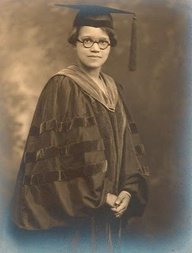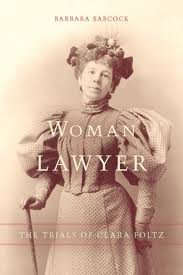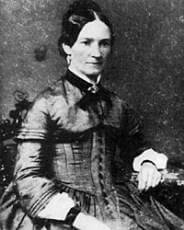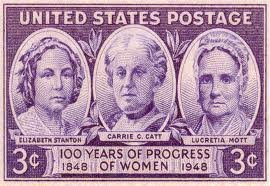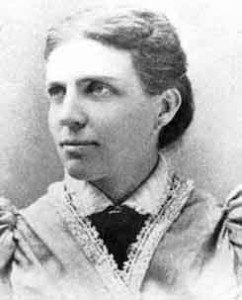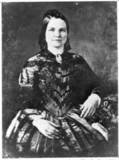A Pioneer in American Law
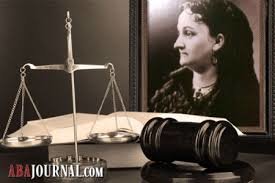 Myra Bradwell, a publisher and political activist, almost became the first woman lawyer in Illinois. Though she never practiced law, she became one of the most influential people in the legal profession, and paved the way for future women lawyers. Through her publication, the Chicago Legal News, she initiated many important legal and social reforms.
Myra Bradwell, a publisher and political activist, almost became the first woman lawyer in Illinois. Though she never practiced law, she became one of the most influential people in the legal profession, and paved the way for future women lawyers. Through her publication, the Chicago Legal News, she initiated many important legal and social reforms.
Early Years
Myra Colby was born on February 12, 1831 in Manchester, Vermont, the youngest of five children of Eben and Abigail Willey Colby. Shortly after Myra’s birth, the family moved to Portage in western New York, where they lived until 1843. They then moved to Shaumberg, Illinois, near Chicago. She attended finishing school in Kenosha, Wisconsin, and completed her education at the Elgin Female Seminary. There were no women’s colleges in that part of the country, so she taught school for a few years.
Marriage and Family
While attending the seminary, Myra met James Bradwell, a Tennessee law student who was visiting Elgin. He came from a family of poor English immigrants, and was financing his education by doing manual labor, which led the Colby family to disapprove of their relationship.
Nevertheless, Myra Colby married James Bradwell on May 18, 1852 and moved with him to Memphis, Tennessee, where they opened their own private school, while James continued to study law. They had four children, two of whom died at an early age. In 1854 the Bradwells returned to Illinois and settled in Chicago, where James was admitted to the bar in 1855 and established a successful law practice.
No law school in the Midwest would admit women at that time – the first was Washington University in St. Louis (1869). Therefore, Myra Bradwell took the other approach to studying law by serving as an apprentice in her husband’s law office. She cared for their children and home, and used her growing legal knowledge to help her husband in the office. In 1861, James was elected as a Cook County judge.
When the Civil War began, she joined the Northwestern Sanitary Commission and was involved in planning a successful fund-raising fair in Chicago, which provided supplies and other support for Union soldiers and their widows and orphans. In the process she improved her organizational skills. She also met Mary Livermore and others who were active in the women’s suffrage movement.
Women’s Suffrage Movement
After the Civil War, the women’s suffrage movement split because of differences over the rights of African American men and the rights of women, especially related to the passage of the Fourteenth Amendment. Myra Bradwell joined the faction including Lucy Stone, Julia Ward Howe and Frederick Douglass that supported the Fourteenth Amendment, though it only gave voting rights to men.
Bradwell also became an active member of the Illinois Woman Suffrage Association. In 1869 she helped organize Chicago’s first suffrage convention and aided in establishing the American Woman Suffrage Association in Cleveland, serving on its executive committee. Her influence with lawyers, judges and lawmakers gave her enormous impact as a women’s rights advocate and she became one of the Midwest’s most notable suffragists.
Myra was deeply committed to changing women’s second-class status. She used her column, “Law Relating to Women,” in the Chicago Legal News to urge the legal and political equality of women in property rights, service on juries and law school admissions. She exhorted state officials of both parties to end discrimination against women in employment. The News also provided editorial support to women around the country seeking to obtain law licenses in their own states.
While James Bradwell served in the Illinois state legislature, Myra often drafted legislation that he ushered into law, including a statute that gave all people, men and women, the right to practice any profession. Some of the bills she drafted gave women the right to run for office in the Illinois public school system, to become notaries public, and gave women equal rights to the custody of their children in case of divorce. The Chicago Legal News served as her mouthpiece during this process.
The Chicago Legal News
In October 1868 Myra Bradwell launched her own career by establishing the Chicago Legal News, the first weekly law journal published in the Midwest. Each week she published the opinions in recent state and federal court cases and other legal information. It eventually became popular throughout the country, and was the most widely read legal paper in the United States, with Bradwell serving as publisher, editor and business manager.
She refused to accept the narrow social role society allowed women. She dedicated her newspaper to changing women’s status in society, writing a column entitled “Law Relating to Women.” She was an acknowledged commentator on the legal developments of her time and a passionate campaigner for social reform. She attacked lawyers and judges she considered incompetent and morally deficient.
She also established the Chicago Legal News Company, which published other periodicals and printed and sold stationery and legal forms to a wide clientele. The building that housed her company’s operations was destroyed in the Chicago fire of 1871. She managed to save the subscription book for the newspaper and when she resumed publishing from a temporary office in Milwaukee, she capitalized on the losses caused by the fire.
Recognizing that lawyers in Chicago would have to replace their lost law libraries, she solicited advertisements from legal book publishers. In addition, Bradwell printed and sold back copies of the Chicago Legal News to replace those that were lost in the fire. The Illinois legislature designated the her paper as the official publisher of all legal records lost in the fire.
Application for a Law License
In August 1869, Bradwell passed the qualifying examination and the Illinois Seventh Circuit Judge pronounced her qualified. Following customary procedure her application was then submitted to the Illinois Supreme Court, requesting that she be issued a license to practice law. Her application was denied on the grounds that as a married woman she could not legally enter into any contracts for professional services.
Exactly two months after passing the bar examination with flying colors, she received the following communication from the reporter for the Illinois Supreme Court:
Madam: The court instructs me to inform you that they are compelled to deny your application for a license to practice as an attorney-at-law in the courts of this State, upon the ground that you would not be bound by the [contractual] obligations necessary to be assumed where the relation of attorney and client shall exist, by reason of the DISABILITY IMPOSED BY YOUR MARRIED CONDITION – it being assumed that you are a married woman…. Until such DISABILITY shall be removed by legislation, the court regards itself as powerless to grant your application.
The common law doctrine that denied married women to make any contract was known as coverture. However, Bradwell argued that several states had moved away from this doctrine and were adopting statutes that allowed married women to enter into contracts and to own property without the consent of their husbands.
She asked the court to reconsider, arguing that under Illinois law marriage was not grounds for disqualification to practice law because the statutes that allowed married women to own property should be interpreted as allowing them to enter into contracts as well.
The Court acknowledged Bradwell’s arguments, but believed that the state had not completely repealed the doctrine. The court stated that state law had not advanced sufficiently to allow women to practice law. On February 5, 1870, the Illinois high court again denied her claim, this time because she was a woman, noting that “God designed the sexes to occupy different spheres of action.” Bradwell attacked the decision through her editorials in the News.
Appeal to the U.S. Supreme Court
Bradwell filed a writ of error in the U.S. Supreme Court in December of 1871; Senator Matthew Hale Carpenter represented her before the high court. In his oral argument on January 18, 1872, Carpenter stated that the right to a livelihood was protected by the Privileges and Immunities clause of the recently ratified Fourteenth Amendment and that, by refusing Bradwell admission to the bar, Illinois had violated her rights.
While awaiting the Court’s decision, Illinois Governor John Palmer greatly disappointed Bradwell by refusing to appoint her a notary public, despite the recommendation of sixty Chicago lawyers. Palmer attributed his refusal to her status as a married woman, saying that she could not execute the bond as the law required.
Alta Hulett, a single woman from Illinois, was also denied a license to practice law. With Bradwell’s help, Hulett drafted a bill prohibiting discrimination on the basis of gender, which stated that, “No person shall be precluded or debarred from any occupation, profession or employment (except the military) on account of gender.”
The bill was passed in March 1872, with help from Bradwell’s lobbying, and Hulett became the first woman lawyer in Illinois in June 1873. Although Bradwell had not resubmitted her application for a license to practice law, she was made an honorary member of the state bar association.
The Supreme Court did not issue an opinion in Bradwell v. Illinois until the spring of 1873, when a majority vote of 8 to 1 (Chief Justice Salmon P. Chase was the lone dissenter) upheld the opinion of the state court on the grounds that the Privileges and Immunities Clause only provides protection against state abridgement of a limited number of rights of national citizenship and that “the right to admission to practice in the courts of a State is not one of them.”
Justice Joseph Bradley wrote:
The natural and proper timidity and delicacy which belongs to the female sex evidently unfits it [?] for many of the occupations of civil life. The constitution of the family organization, which is founded in the divine ordinance, as well as in the nature of things, indicates the domestic sphere as that which properly belongs to the domain and functions of womanhood.
The harmony, not to say the identity, of interests and views which belong, or should belong, to the family institution is repugnant to the idea for a woman adopting a distinct and independent career from that of her husband; for these reasons I think that the laws of Illinois now complained of are not obnoxious to the charge of any abridging of the privileges and immunities… [T]he paramount destiny and mission of woman are to fulfill the noble and benign offices of wife and mother. This is the law of the Creator.”
Asylum Reform
Bradwell also advocated for the rights of people in institutions, including women, children, the mentally ill and prison inmates. In Illinois and other states, a married woman could be declared insane by her husband and confined to an asylum without a hearing. Elizabeth Packard was responsible for passage of two laws that prohibited men from institutionalizing their wives without a jury trial and order of a court.
A “private madhouse” bill was introduced to nullify the Packard law and was reintroduced several times over the next twenty years. Bradwell campaigned against the bill in the Chicago Legal News; it was never passed. She was also involved in the case of her friend Mary Todd Lincoln, widow of President Abraham Lincoln, who was incarcerated in an insane asylum in 1875 by her son Robert, who claimed she was insane.
When Bradwell learned of her friend’s confinement, she immediately filed an appeal on Mrs. Lincoln’s behalf and after four months of confinement, the former First Lady was released to the care of her sister Elizabeth Edwards in Springfield, Illinois. On June 15, 1876, Mary was officially declared sane in a Chicago court.
In 1876, she was appointed a member of the Illinois Centennial Association, to represent the state in the Centennial Exposition in Philadelphia, which celebrated the 100th anniversary of the Declaration of Independence. She also played a major role in winning the 1893 World’s Fair for Chicago.
Both of her children – Bessie Bradwell Helmer and Thomas Bradwell – continued to live with their parents even after marrying and having children of their own. Both became lawyers.
Later Years
Bradwell never again requested a license to practice law. However, as the Chicago Tribune reported in April 1890, of their own volition, the Illinois Supreme Court approved her original 1869 application and admitted her to the state bar:
…upon the original record, every member of the Illinois Supreme Court cordially acquiesced in granting, on the court’s own motion, a license as an attorney and counselor-at-law to Mrs. Bradwell.
In March 1892 she was granted the right to practice before the U.S. Supreme Court. Then, just months before her death, the Illinois Bar Association called Bradwell “the pioneer woman lawyer” because she had paved the way for others to follow.
Myra Bradwell died on February 14, 1894, two days after her sixty-third birthday.
The tribute to Bradwell in the February 24, 1894 edition of the Chicago Legal News stated:
The future historian will accord her the breaking of the chain that bound woman to a life of household drudgery. She opened the door of the professions to her sex, and compelled law makers and judges as well, to proclaim that it was not a crime to be born a woman.
Daughter Bessie, an 1882 graduate of Union College of Law (later Northwestern University), continued to publish the Chicago Legal News until 1925. Myra’s son and husband managed the printing company.
The Myra Bradwell Award is presented every year to a member of the Minnesota Women Lawyers who is a leader in her field and who has exemplified excellence, professionalism and ethics and/or an attorney who has reached out to assist other women as a mentor or role model.
SOURCES
Wikipedia: Myra Bradwell
Library of Congress: Myra Bradwell by Margaret Wood
American National Biography: Myra Bradwell
Encyclopedia Britannica: Myra Colby Bradwell
